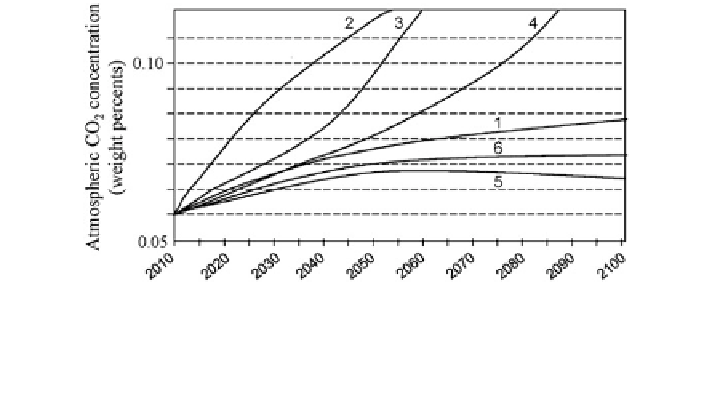Geoscience Reference
In-Depth Information
Fig. 8.19 The dynamics of CO
2
concentration for different scenarios of changing forest areas
within the framework of the scenario after Demirchian et al. (2002): 1 rates of changes of the forest
areas remain as of 1970; 2 by 2050 the forests will be liquidated at all; 3 by 2050 the area of the
forests is reduced by 50 %; 4 by 10 %; 5 by 2050 the area of the forests increases by 50 %; 6 by
10 %
by the end of the 21st century. On the contrary, a 10 % increase of the forested areas
decreases the concentration of atmospheric CO
2
by 15 %. With a 50 % increase of
the forested areas by 2050, a decrease of atmospheric CO
2
by 2100 will constitute
60 % relative to its possible value, with the scale of impacts on the forest ecosystems,
observed in the end of the 20th century, preserved. Hence, variations of the forested
areas in the biosphere even within
10 % can substantially change the dynamics of
numerous components of the global ecosystem.
Table
8.8
exempli
±
es the calculation of the CO
2
sinks into the vegetation cover
on the territory of Russia. Such calculations with the use of the global model of the
N-S system demonstrate the dynamics of the CO
2
fl
fluxes mosaic in the system
atmosphere-plant-soil. The knowledge of this mosaic makes it possible to assess the
role of concrete types of the soil-plant formations in the regional balance of carbon,
and on this basis, to calculate the global
fluxes of carbon dioxide on the atmo-
sphere-land border. Similar calculations are also possible for the atmosphere-ocean
system.
Table
8.9
demonstrates the consequences of changing the global structure of the
soil-plant formations for the dynamics of CO
2
assimilation by vegetation. As seen,
the anthropogenic change of the vegetation cover substantially changes the balance
components in the global carbon cycle. Clearly, such experiments require a thor-
ough analysis of data on the possibility of transformation of vegetation covers with
account of climatic zones and biocenological consistency. Nevertheless, such
hypothetical experiments are useful for general assessments of possible ranges of
anthropogenic impacts on the global carbon cycle. For instance, natural and
anthropogenic cataclysms connected with forest
fl
fires introduce annually consider-
able changes into this cycle, because they change numerous
fluxes and supplies of
carbon over large territories. Tables
8.10
,
8.11
and
8.12
give estimates of deviations
in the content of carbon in the basic biospheric reservoirs with forests
fl
fires in

Search WWH ::

Custom Search